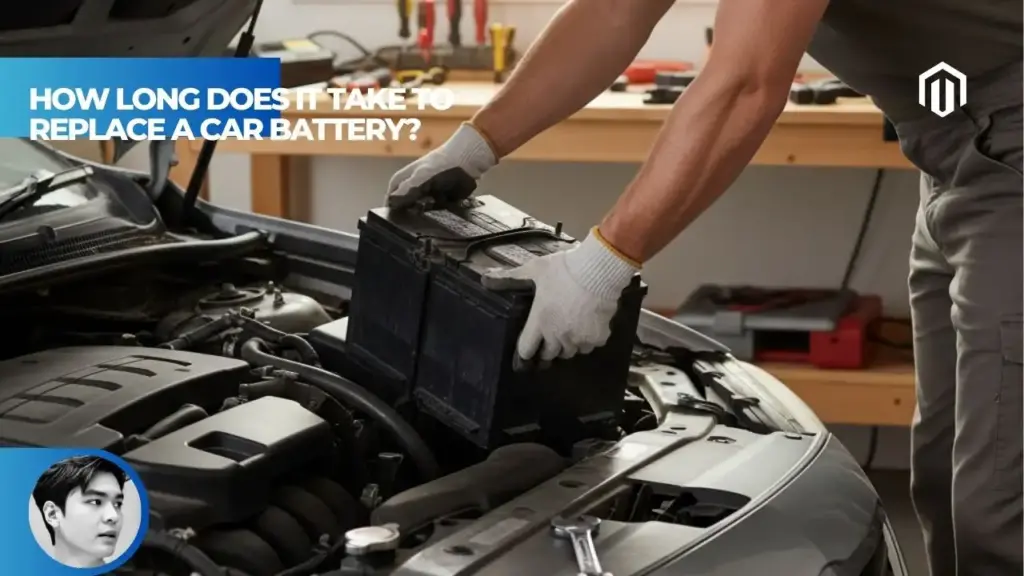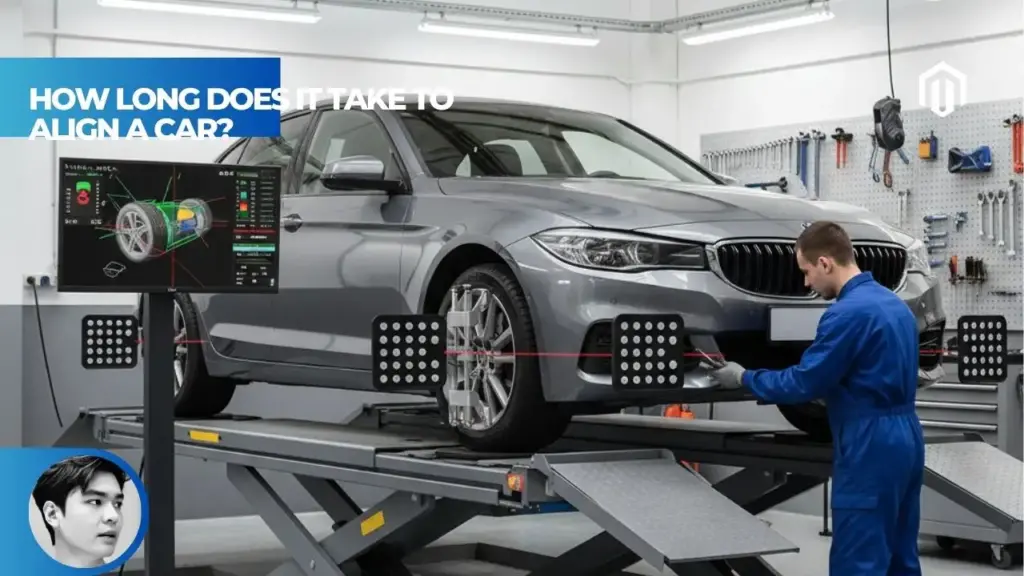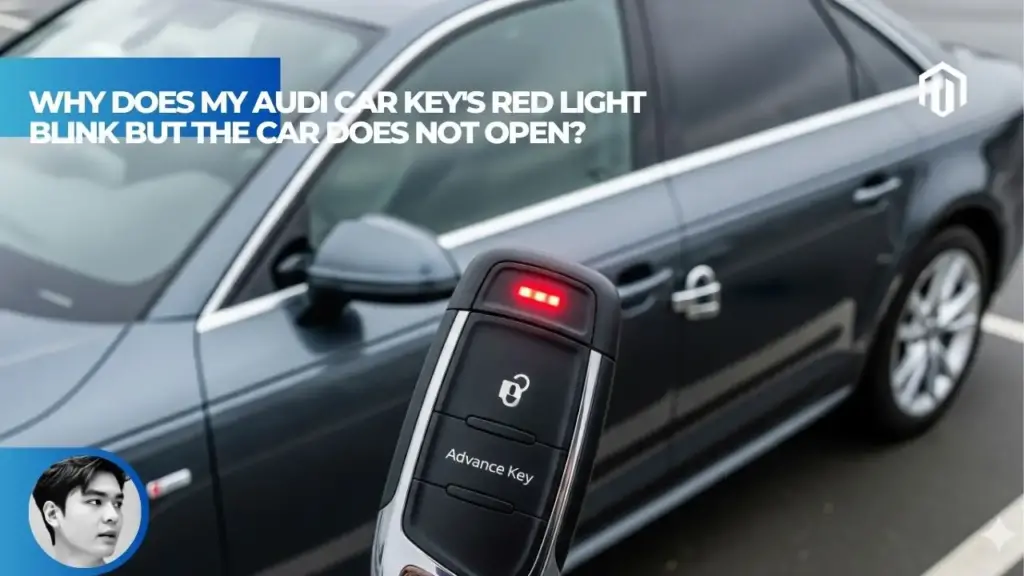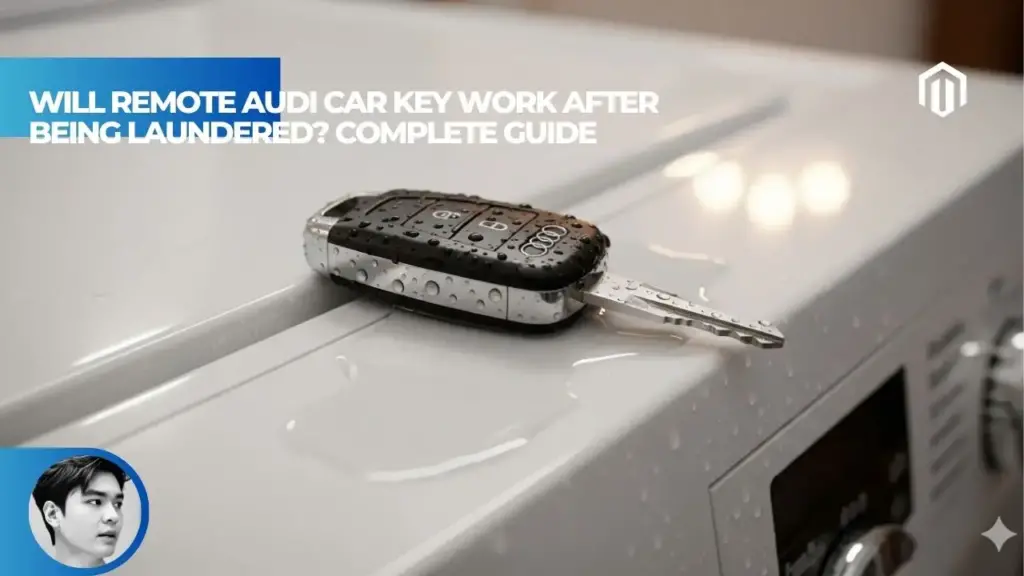You may also like:
- 【Explained】How Long Does It Really Take to Charge a Car Battery?
- 【Explained】Can You Jumpstart a Car With a Bad Alternator?
- 【Explained】Why Does My Audi Car Key’s Red Light Blink But the Car Does Not Open? (5 Fixes)
- 【Explained】How Long Does It Take to Buy a Car? A Step-by-Step Timeline
- 【Explained】How Long Can a Car Sit Without Being Driven? The Dangers of Inactivity
Replacing a car battery typically takes 15-60 minutes for most vehicles, with professional mechanics completing the job in 15-30 minutes while DIY replacement usually requires 30-45 minutes. The exact time depends on battery location, terminal condition, and vehicle complexity—factors that can extend simple replacements to over an hour for certain luxury or hybrid models.
Whether you’re stranded with a dead battery or planning preventive maintenance, knowing the replacement timeline helps you schedule appropriately and decide between professional service or DIY installation. Understanding each factor affecting replacement time ensures you’re prepared for this essential maintenance task.
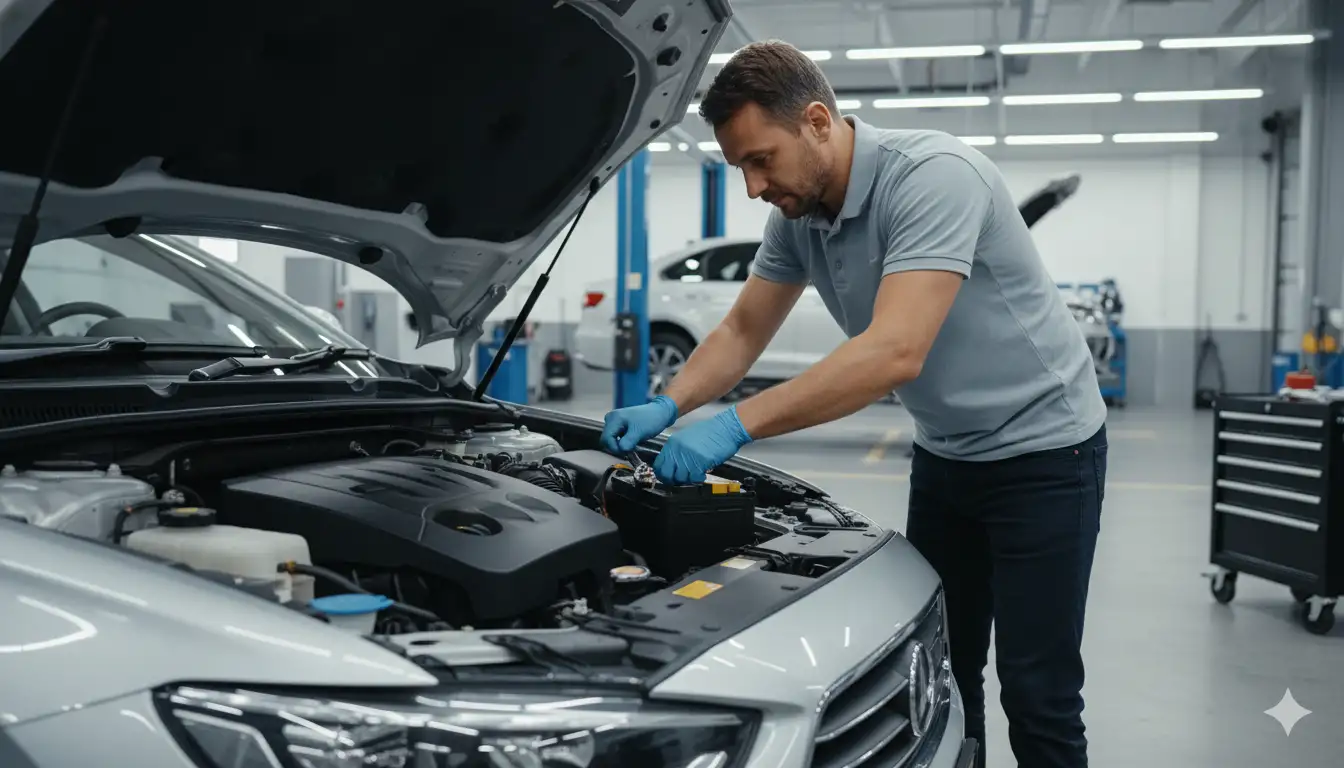
Battery Replacement Time Overview: 15 to 60 Minutes
Quick Battery Replacement for Standard Vehicles
Standard vehicles with easily accessible batteries under the hood can have replacements completed in as little as 15 minutes by experienced technicians[1]. Most sedans, SUVs, and trucks fall into this category, featuring straightforward battery compartments designed for quick service.
The rapid replacement time assumes ideal conditions: clean terminals, proper tools readily available, and a standard Group 24 or Group 35 battery size. Professional mechanics working at Autvex-certified service centers maintain efficiency through repetition and specialized equipment that speeds the process.
Quick replacement doesn’t mean cutting corners. Even 15-minute installations include proper testing of the charging system, secure mounting, and verification that all electrical systems function correctly after installation.
How Long to Change Car Battery in Different Scenarios
Battery replacement timeframes vary significantly based on specific circumstances. Understanding these scenarios helps set realistic expectations for your particular situation.
| Scenario | Time Required | Key Factors |
|---|---|---|
| Standard sedan at shop | 15-30 minutes | Easy access, professional tools |
| DIY first-timer | 45-60 minutes | Learning curve, gathering tools |
| Luxury vehicle | 30-60 minutes | Computer resets, special procedures |
| Roadside emergency | 20-40 minutes | Weather, location constraints |
| Corroded terminals | 25-45 minutes | Additional cleaning required |
Environmental factors significantly impact replacement time. Cold weather makes batteries harder to handle and can slow the process by 10-15 minutes. Rain or snow adds safety considerations that extend timeline further.
Mechanic Battery Replacement Time vs DIY
Professional mechanics complete battery replacements in 15-30 minutes for standard vehicles, leveraging experience and specialized tools[2]. Their efficiency comes from performing dozens of replacements monthly, knowing exactly where each component is located and potential complications to avoid.
DIY replacement typically takes 30-45 minutes for those with basic automotive knowledge, extending to an hour for complete beginners. The time difference stems from several factors: locating proper tools, referencing instructions, and proceeding cautiously to avoid mistakes.
According to Autvex automotive experts, the time investment for DIY often exceeds the labor cost savings, especially when considering potential complications like lost radio codes or computer memory resets that professionals handle routinely.
DIY vs Professional Battery Replacement Time
DIY Battery Replacement Time (30-45 Minutes)
DIY battery replacement realistically requires 30-45 minutes for prepared individuals, though first-timers should budget a full hour[3]. This timeframe includes gathering tools, removing the old battery, cleaning connections, installing the new unit, and properly disposing of the old battery.
The DIY process breaks down as follows:
- Preparation and safety (5-10 minutes): Gathering tools, putting on safety gear
- Removing old battery (10-15 minutes): Disconnecting terminals, removing hold-down
- Cleaning and inspection (5-10 minutes): Cleaning corrosion, checking cables
- Installing new battery (10-15 minutes): Positioning, connecting, securing
- Testing and cleanup (5 minutes): Verifying operation, storing tools
Common DIY delays include searching for the correct socket size, dealing with stuck bolts, or discovering additional corrosion requiring extra cleaning. Having all tools ready beforehand significantly reduces total time.
How Long Does a Mechanic Take to Replace a Car Battery (15-30 Minutes)
Professional mechanics average 15-30 minutes for standard battery replacements, with many completing simple swaps in under 20 minutes[2]. This efficiency reflects their investment in proper equipment: pneumatic tools, battery carriers, and diagnostic systems that streamline the process.
Shops typically follow standardized procedures that maximize efficiency while ensuring quality. They perform complementary services during replacement like testing the alternator, checking belt tension, and applying terminal protection spray—all within the standard timeframe.
The professional advantage extends beyond speed. Mechanics handle complications like BMW’s battery registration requirement or module programming that DIY installers might not know about, potentially saving hours of troubleshooting.
Mobile Battery Replacement Service Duration
Mobile battery replacement services complete most jobs in 20-40 minutes at your location, combining professional efficiency with ultimate convenience[4]. These services arrive with fully stocked vans containing various battery sizes and all necessary tools.
The mobile service timeline includes:
- Arrival and vehicle assessment (5 minutes)
- Battery testing and confirmation (5 minutes)
- Replacement process (15-20 minutes)
- System testing and paperwork (5-10 minutes)
Premium mobile services often cost $20-40 more than shop installation but save significant time by eliminating travel and waiting room delays. Many offer same-day service with 2-hour response windows, ideal for emergency situations.
Factors Influencing Battery Replacement Time
Car Battery Location and Accessibility
Battery location dramatically impacts replacement time, with under-hood installations taking 15-20 minutes while trunk or under-seat locations can require 45-60 minutes[1]. Modern vehicles increasingly place batteries in protected locations to save engine bay space and improve weight distribution.
Easy-access locations include most American trucks and SUVs where batteries sit prominently in the engine compartment. These designs prioritize serviceability, allowing quick replacement without removing other components.
Challenging locations require additional disassembly:
- Trunk mounting: Remove floor panels, spare tire (Chrysler 300, some BMWs)
- Under rear seat: Remove seat cushions and brackets (some Audis, Cadillacs)
- Wheel well access: Remove inner fender liner (Chrysler Sebring, Dodge Journey)
- Behind headlight: Remove headlight assembly (some European models)
Battery Under Seat or Trunk Complications
Batteries located under seats or in trunks add 15-30 minutes to replacement time due to access requirements. These locations, common in luxury sedans and some hybrids, require removing interior panels, seats, or cargo area components.
The Audi A4 exemplifies this challenge, with its battery beneath the spare tire in the trunk. Replacement involves removing the trunk floor, spare tire, and tools before accessing the battery compartment—adding 20 minutes versus standard hood access.
Safety considerations also extend timeline. Batteries in passenger compartments require extra ventilation precautions and careful handling to prevent acid spills on interior surfaces. Professional shops use specialized extraction tools to safely remove batteries from tight spaces.
Corroded Terminals Adding 5-10 Minutes
Terminal corrosion adds 5-10 minutes to any battery replacement as cleaning becomes mandatory for proper electrical connection[5]. The white or blue-green buildup common on battery terminals must be completely removed before installing new components.
Severe corrosion sometimes damages cable ends beyond cleaning, requiring terminal replacement that adds another 15-20 minutes. Professional shops stock replacement terminals and can perform this repair immediately, while DIY installers might need parts store trips.
Corrosion cleaning process:
- Apply baking soda solution to neutralize acid
- Scrub with wire brush until metal shines
- Rinse with clean water and dry thoroughly
- Apply dielectric grease to prevent future corrosion
Step-by-Step Battery Replacement Process
Disconnecting Car Battery Safely
Proper disconnection takes 5-7 minutes but prevents dangerous sparks and protects sensitive electronics. Always remove the negative terminal first, then positive—reversing this order when reconnecting to minimize short circuit risk.
Safety protocol requires:
- Turn off engine and remove keys
- Ensure all accessories are off
- Wear safety glasses and gloves
- Keep metal tools away from both terminals simultaneously
- Secure loose clothing and jewelry
Modern vehicles may display warning messages or require system resets after battery disconnection. Some luxury models need constant power supply during replacement to preserve settings, requiring special jumper boxes that professionals use routinely.
Cleaning Battery Terminals and Tray
Terminal and tray cleaning typically requires 5-10 minutes but proves essential for preventing future corrosion and ensuring solid electrical connections[5]. This often-skipped step significantly impacts battery longevity and system reliability.
The battery tray accumulates debris and corrosion that can cause new batteries to fail prematurely. Professional cleaning involves vacuuming debris, neutralizing acid residue, and applying protective coating to metal surfaces.
Proper cleaning materials include:
- Wire brush or battery terminal cleaner tool
- Baking soda and water solution
- Shop rags or paper towels
- Corrosion preventive spray
- Dielectric grease for terminals
Installing New Car Battery Properly
Installation takes 10-15 minutes when following proper procedures that ensure safe, secure mounting. Rushing this phase risks loose connections causing intermittent starting problems or batteries shifting during driving.
Critical installation steps:
- Position battery squarely in tray
- Secure hold-down bracket or clamp firmly
- Connect positive terminal first, tightening to specification
- Connect negative terminal last
- Apply terminal protection spray
- Test starting and electrical systems
Proper torque on terminal connections prevents both loosening and over-tightening that cracks battery posts. Most terminals require 50-70 inch-pounds of torque—firm but not excessive force.
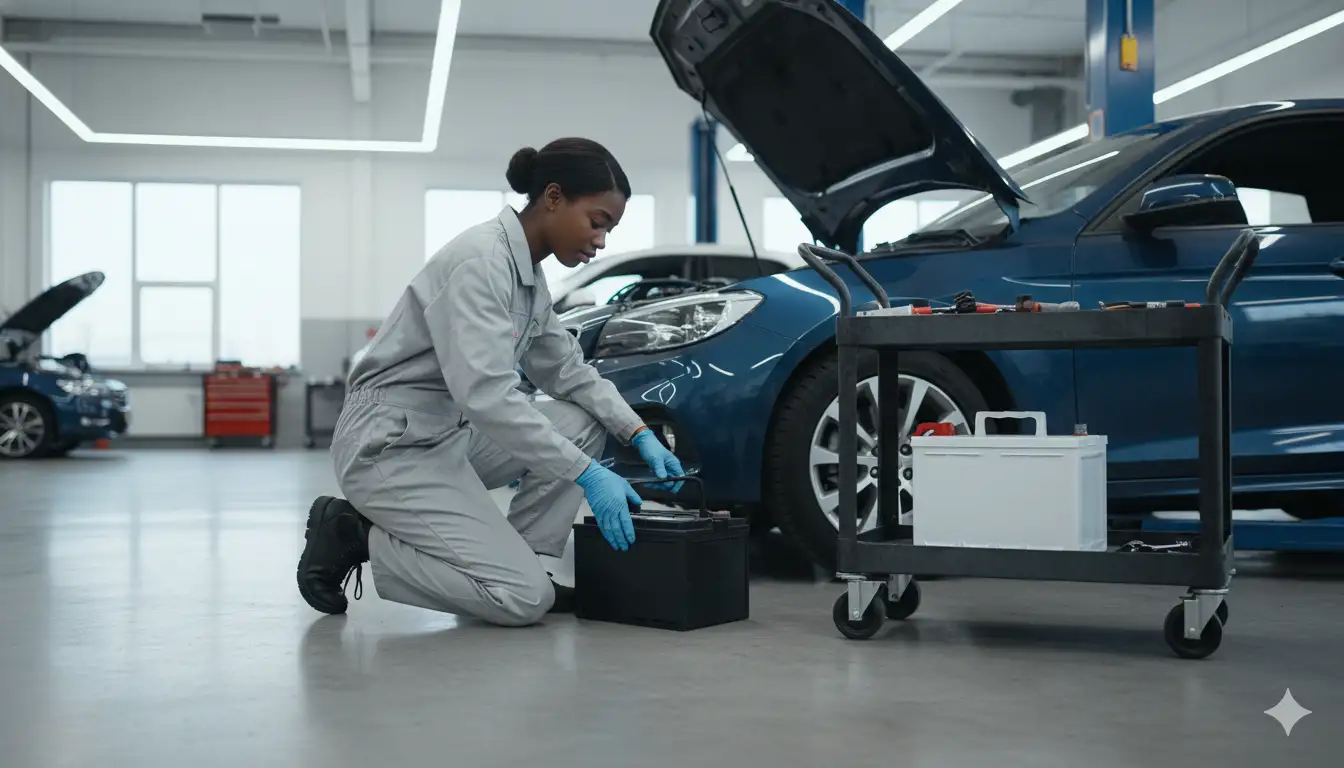
Vehicle-Specific Battery Replacement Times
Luxury Car Battery Replacement Complexity
Luxury vehicles often require 45-60 minutes for battery replacement due to additional complexity beyond simple power supply exchange[6]. These vehicles feature battery management systems requiring computer programming after installation.
European luxury brands particularly complicate replacement. BMW requires “registering” new batteries to the car’s computer, informing the charging system of the new battery’s specifications. This process alone adds 15-20 minutes and requires specialized diagnostic equipment.
Mercedes-Benz vehicles often have auxiliary batteries powering convenience features, requiring both batteries be replaced simultaneously for proper operation. German luxury SUVs frequently position batteries under floors or behind panels, extending access time.
Tesla 12V Battery Replacement Time
Tesla’s 12V battery replacement takes 20-45 minutes depending on model and experience level. While Teslas are electric, they maintain traditional 12V batteries powering accessories and computer systems when the main battery pack is offline.
Model S and Model X batteries locate in the front trunk (frunk), requiring panel removal but offering relatively easy access once opened. Model 3 and Model Y position batteries more challengingly, sometimes requiring wheel well liner removal.
Tesla’s unique consideration involves placing the vehicle in “Service Mode” before replacement, preventing high-voltage system activation during work. Mobile Tesla service technicians complete replacements efficiently, but DIY attempts without proper knowledge risk triggering error codes.
Hybrid Car Battery Considerations
Hybrid vehicles have both high-voltage traction batteries and traditional 12V auxiliary batteries, with the 12V replacement taking 30-45 minutes on average[7]. These auxiliary batteries often hide in unusual locations to maximize cargo space.
The Toyota Prius exemplifies hybrid complexity, with its 12V battery in the rear passenger-side trunk area. Accessing requires removing multiple panels and carefully routing cables through designed passages. Some mechanics unfamiliar with hybrids quote longer timeframes due to uncertainty.
Safety becomes paramount with hybrids. While 12V battery replacement doesn’t involve high-voltage systems directly, proximity to orange high-voltage cables requires extra caution. Professional hybrid technicians complete replacements faster through familiarity with safety protocols.
Special Tools and Equipment Requirements
Special Tools for Car Battery Access
Certain vehicles require specialized tools that can add 10-15 minutes to replacement time if not readily available. While most batteries need only basic hand tools, some manufacturers use unique fasteners or configurations requiring specific equipment.
Essential special tools include:
- Battery terminal pullers: For removing corroded terminals without damage
- Memory savers: Maintain computer settings during replacement
- Extended ratchets: Reach batteries in deep engine bays
- Panel removal tools: Access batteries behind trim pieces
- Torque wrenches: Ensure proper terminal tightness
European vehicles often require specific socket sizes like 10mm and 13mm for battery hold-downs. Some Japanese models use unique battery clamp designs needing special wrenches. Having proper tools ready prevents mid-job hardware store runs.
Battery Terminal Cleaning Equipment
Professional terminal cleaning equipment reduces cleaning time to 3-5 minutes versus 10+ minutes with improvised methods. Specialized tools ensure thorough cleaning without damaging components.
Professional cleaning kit components:
- Battery terminal brush (internal and external)
- Neutralizing spray for acid residue
- Protective coating applicator
- Felt anti-corrosion washers
- Dielectric grease dispensers
DIY alternatives work but take longer. Baking soda and old toothbrushes clean effectively but require more scrubbing. Sandpaper removes corrosion but risks damaging terminal posts if used aggressively.
Professional vs DIY Tool Differences
Professional shops invest in tools that can reduce replacement time by 50% or more compared to basic DIY equipment[3]. This efficiency justifies labor costs for many customers valuing time over money.
| Tool Category | Professional Equipment | DIY Alternative | Time Difference |
|---|---|---|---|
| Lifting | Hydraulic battery carrier | Manual lifting | 5 minutes saved |
| Fastening | Pneumatic/electric ratchets | Hand ratchets | 5-10 minutes saved |
| Testing | Digital load testers | Basic multimeter | 10 minutes saved |
| Cleaning | Pneumatic brushes | Hand brushes | 5 minutes saved |
Professional diagnostic scanners also identify issues beyond simple battery failure, potentially saving customers from repeat visits when underlying problems exist.
Common Battery Replacement Complications
Why Battery Replacement Sometimes Takes Longer
Unexpected complications can extend battery replacement from 30 minutes to over an hour. Understanding potential issues helps set realistic expectations and explains varying shop estimates.
Common complications include:
- Seized hold-down bolts from corrosion (add 15-20 minutes)
- Swollen batteries stuck in tight spaces (add 10-15 minutes)
- Damaged cable ends requiring replacement (add 20-30 minutes)
- Computer system errors after disconnection (add 15-45 minutes)
- Wrong battery size requiring exchange (add 30+ minutes)
Weather extremes compound complications. Winter replacements with frozen bolts and stiff cables take longer. Summer heat makes handling batteries uncomfortable, slowing the process.
Electrical System Problems During Replacement
Electrical complications during replacement can add 15-60 minutes for diagnosis and resolution. Modern vehicles’ complex electrical systems sometimes react unexpectedly to power interruption.
Common electrical issues:
- Radio lockout requiring security codes
- Power window reset procedures needed
- Steering angle sensor calibration required
- Idle relearn processes must complete
- Warning lights requiring diagnostic reset
Professional shops anticipate these issues, maintaining databases of reset procedures and security codes. DIY installers might spend hours researching solutions to problems professionals resolve in minutes.
Difficult Battery Change Scenarios
Certain scenarios transform simple battery replacement into complex procedures requiring 60-90 minutes or more. Recognizing these situations helps decide between DIY attempts and professional service.
Challenging scenarios include:
- Frozen batteries in winter requiring warming
- Leak damage necessitating tray replacement
- Previous improper installation with crossed threads
- Aftermarket accessories complicating access
- Accident damage affecting battery area
Emergency roadside replacements present unique challenges. Limited tools, poor lighting, and weather exposure extend normal timeframes. Professional roadside assistance handles these situations efficiently through experience and proper equipment.
Related Battery Service Times
Free Battery Check Duration
Free battery testing at auto parts stores or service centers typically takes 5-10 minutes using digital analyzers that quickly assess battery condition[8]. This preventive service identifies failing batteries before complete failure occurs.
Modern battery testers measure:
- Cold cranking amps (CCA) capacity
- Internal resistance
- Voltage under load
- Cell balance in AGM batteries
- Charging system performance
Many retailers offer free testing hoping to sell replacement batteries. However, these quick tests provide valuable information regardless of purchase decisions. Regular testing every 6 months identifies gradual capacity loss.
Roadside Assistance Battery Replacement
Roadside assistance services complete battery replacements in 20-40 minutes from arrival, though response time varies by location and service level. Premium services like AAA Premier guarantee one-hour response in metropolitan areas.
The roadside process includes:
- Arrival and member verification (5 minutes)
- Battery testing and diagnosis (5 minutes)
- Replacement if battery available (15-25 minutes)
- Jump start if replacement unavailable (5-10 minutes)
- Documentation and payment (5 minutes)
Some roadside services only provide jump starts, requiring towing to shops for replacement. Verify your coverage includes battery replacement to avoid surprises during emergencies.
Auto Center Battery Replacement Services
Major auto service centers like those at Autvex partner locations typically complete battery replacements in 30-45 minutes including complimentary services. These centers often provide more than simple battery swaps.
Standard auto center service includes:
- Complete electrical system test
- Battery registration for applicable vehicles
- Terminal cleaning and protection
- Disposal of old battery
- Nationwide warranty activation
- Reset of vehicle systems
Appointment scheduling reduces wait times, though many centers accept walk-ins. Saturday mornings see highest demand, potentially extending service times. Calling ahead confirms battery availability and provides accurate time estimates.
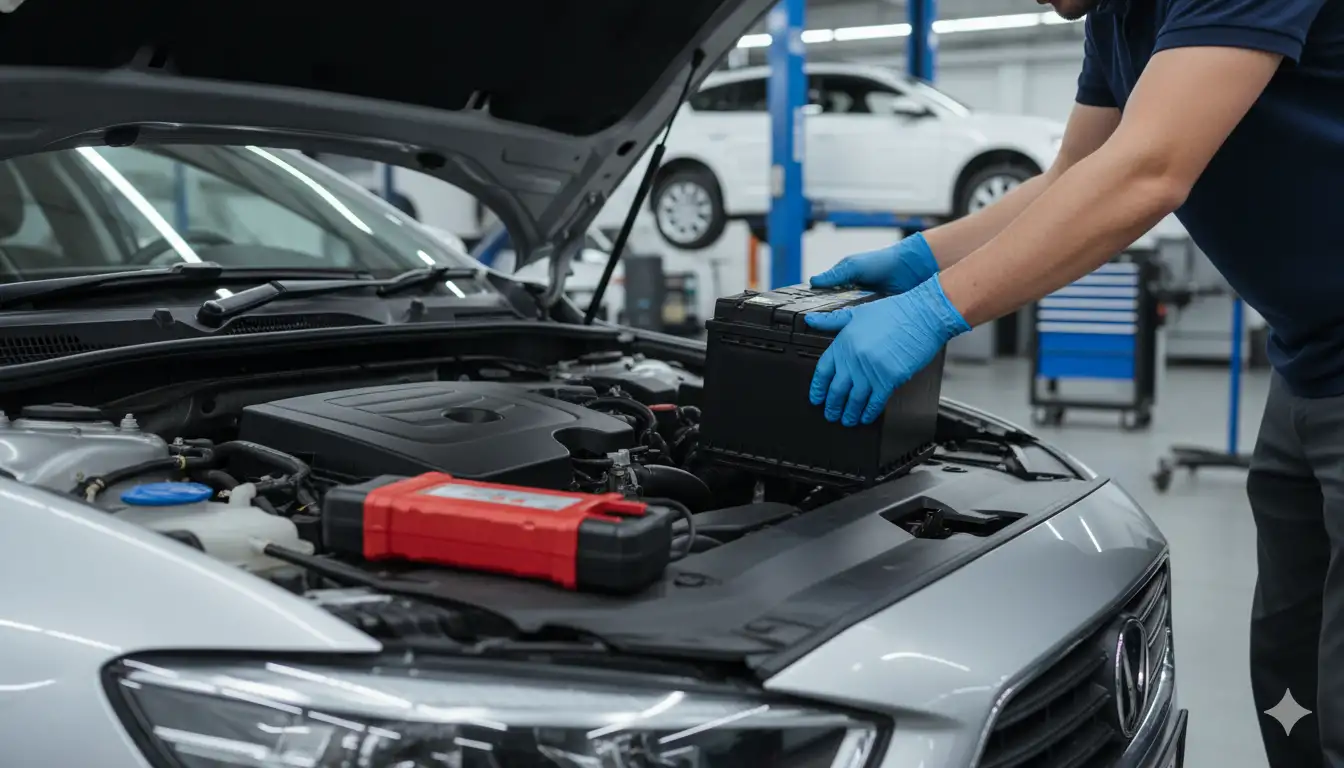
Key Takeaways
- Standard replacements take 15-30 minutes professionally, 30-45 minutes DIY
- Battery location impacts time most—trunk/seat positions add 15-30 minutes
- Corroded terminals add 5-10 minutes for necessary cleaning
- Luxury vehicles require 45-60 minutes due to programming needs
- Mobile services complete jobs in 20-40 minutes at your location
- Professional tools save 50% time versus basic DIY equipment
- Complications can extend simple jobs to over an hour
Next Steps
Schedule a battery test immediately if you notice slow cranking, dim lights, or your battery exceeds three years old. Most auto parts stores provide free testing that takes just 10 minutes and identifies problems before failure. Keep your battery manufacture date documented—batteries typically last 3-5 years depending on climate and usage.
For DIY replacement, gather necessary tools beforehand: safety glasses, gloves, correct wrench sizes, terminal cleaner, and memory saver if needed. Watch vehicle-specific videos demonstrating your model’s battery location and any special procedures. Budget 60 minutes for your first DIY attempt, allowing time for unexpected complications.
Professional replacement makes sense for difficult battery locations, luxury vehicles requiring programming, or when time matters more than saving $20-40 in labor. Schedule service during slower weekday periods for fastest turnaround. Ask about warranties—quality batteries include free replacement periods that professional installation helps protect.
Consider mobile battery service for ultimate convenience, especially for home or office parking lots. These services cost slightly more but eliminate travel time and waiting room delays. Many offer same-day response with 2-hour arrival windows, perfect for unexpected failures or busy schedules requiring minimal disruption.
Frequently Asked Questions
How long does it take a mechanic to replace a car battery?
Professional mechanics typically complete battery replacement in 15-30 minutes for standard vehicles with easily accessible batteries. Luxury cars or those with batteries in difficult locations may require up to 60 minutes due to additional programming or access requirements.
How long should I set aside if I replace my car battery myself?
Plan for 30-45 minutes for DIY battery replacement if you have basic automotive knowledge and proper tools ready. First-time DIY installers should budget 60 minutes to allow for learning curve, tool gathering, and potential complications.
Why does a battery replacement sometimes take longer for certain cars?
Some vehicles have batteries in hard-to-reach locations like under seats or in trunks, requiring panel removal that extends replacement time to over an hour. Luxury vehicles also need computer programming after installation, adding 15-20 minutes.
How long does mobile battery replacement take?
Mobile battery replacement services typically complete the job in 20-40 minutes at your location, including testing, replacement, and system verification. Response time varies by location but premium services guarantee arrival within 1-2 hours.
What are the signs that your battery is failing?
Common signs include slow engine cranking, dim or flickering headlights, dashboard warning lights, clicking sounds when starting, and batteries over 3-4 years old showing any performance degradation.
How often should you replace a car battery?
Most car batteries need replacement every 3-5 years, though extreme temperatures, frequent short trips, and leaving lights on can shorten lifespan significantly. Annual testing after year three identifies degradation before complete failure.
References
- Know Car Battery. (2025). How Long Does It Take to Get Car Battery Replaced? https://knowcarbattery.com/replacement/how-long-does-it-take-to-get-car-battery-replaced/
- Heath’s Auto Repair Prescott. (2025). How Long Does It Take To Replace A Battery In A Car? https://heathsautorepairprescott.com/how-long-does-it-take-to-replace-a-battery-in-a-car/
- BateriHub. (2025). DIY vs Professional Car Battery Installation: Which is Better? https://baterihub.com/diy-vs-professional-car-battery-installation/
- Reddit r/Cartalk. (2023). How often do you change your car battery? https://www.reddit.com/r/Cartalk/comments/17vly5v/how_often_do_you_change_your_car_battery/
- WyoTech. (2025). How to Change Your Car Battery. https://www.wyotech.edu/guides/how-to-change-your-car-battery/
- Motorway. (2024). How Long Do Car Batteries Last? (2025 Update). https://motorway.co.uk/sell-my-car/guides/how-long-do-car-batteries-last
- Firestone Complete Auto Care. (2023). How to Know When to Replace Your Car Battery. https://www.firestonecompleteautocare.com/blog/batteries/when-to-replace-car-battery/
- AAA. (2015). Know When to Replace the Car Battery: 8 Key Warning Signs. https://www.aaa.com/autorepair/articles/know-when-to-replace-the-car-battery-8-key-warning-signs

I am a senior automotive analyst at Autvex. Expert vehicle evaluations, in-depth reviews, and objective analysis helping readers make informed automotive decisions with years of industry experience.

